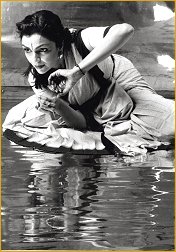 |
 |
LIFE LINES AND WOMEN'S DANCES: A NIGHT TO REMEMBER! by Amina Mire, Toronto |
| October 2002
It was a great pleasure and an honour (honour not in patriarchal sense, but in the more profound moral sense), to have met Lata, Anita and Dipanker in the last Sunday’s preparing of Dance Creations production "Life Lines: an evening of Women's lives in dance & theatre." I must confess that my only knowledge of the existence of this dance company, prior to last Sunday, came after watching an interview Lata gave to TVO. In that interview, Lata has spoken about the loss of her beloved daughter and a husband and how rediscovery of dance as a way of making meanings gave her, as a woman and as an artist, renewed purpose. I was affected by her story. I came to Toronto, roughly, 7 years ago as a graduate student from Winnipeg. Consequently, I do not have close connection with the Toronto's artists of colour's world. It was, therefore, a blessed occasion when my friend, Michael Wilson, invited me to attend the opening of Life Lines. |
| When Anita
Ratnam entered the stage with her opening barely moving dance movement,
I knew something unique and special was happening. Of course, I did not
read the myth of "Vaitharani" (the crossing). Through complex dance movements
accompanied by voice over musical sounds and singing voice, lightening
and costume changes, I read the crossing as an unfolding narrative of a
feminist story. From the outset, what caught my eyes and imagination about
the crossing was Anita's stunning beauty and stage presence.
Here was a stunningly beautiful mature woman using her body to convey a complex story. In this score, I was very happy to see that there was very little actual translation of the myth into spoken language. In so doing, the body of the dancer became the key medium through which the myth of the crossing was conveyed. From my feminist perspective, the crossing was a celebration of the glory and the beauty of mature women's body as a site of accumulated knowledge, artistic/aesthetic creative energy and self-affirming sexuality. |
 |
|
|
"Hyphenated:" this was a wonderful and apt dance production. As a mother of an 18 year-old daughter and a Muslim feminist intellectual, I negotiate my commitment to my feminist values, my Muslim ethical and moral values and everyday white racism and sexism and my role as a mother and a mentor to my daughter. Consequently, I closely identified with the struggles, contradictions faced by the young women dancers in "hyphenated." Soraab-Mirage, perhaps more than any other dance production of the night, Mirage has touched me the most, because, I have lost too many friends and close family members to the senseless violence in Somalia's civil wars. Several times during Lata's performance of Mirage, I felt the need to go out and weep. It is difficult for me to clearly state all the multiple layers of emotions, feelings, and memories mirage invoked in me. From the sweet and hypnotic voice of Marayem Hassan, Lata's narration of her recollection of her memories of her Afghan school friend, her experience as a Muslim teenage girl in a Christian convent school in India through dance movement, spoke words, stage representations, such as, an allusion to the entrapment of the" barka"(faced by thousands of Muslim girls living under frightening fundamentalist theocracy), Mirage made a link between colonial entrapment felt by the performer and her friends in the hands of the nuns and other forms of equally damaging entrapments of women's lives by oppressive patriarchal ethos and rules. But, while the "barka" has now been appropriated as a potent signifier of Muslim oppression against women, doubling the oppressive force of the barka with equally oppressive force of the convent/the school in the nuns' house of colonial horror (of education), Mirage rejects the simplistic and often racism discourse of "class of civilization." At a more personal level, Mirage is a story about precariousness as well as preciousness of friendship, life, memory and identity. In conclusion,
I enjoyed tremendously, "Life Lines: an evening of women's lives in dance
& theatre."
|
||